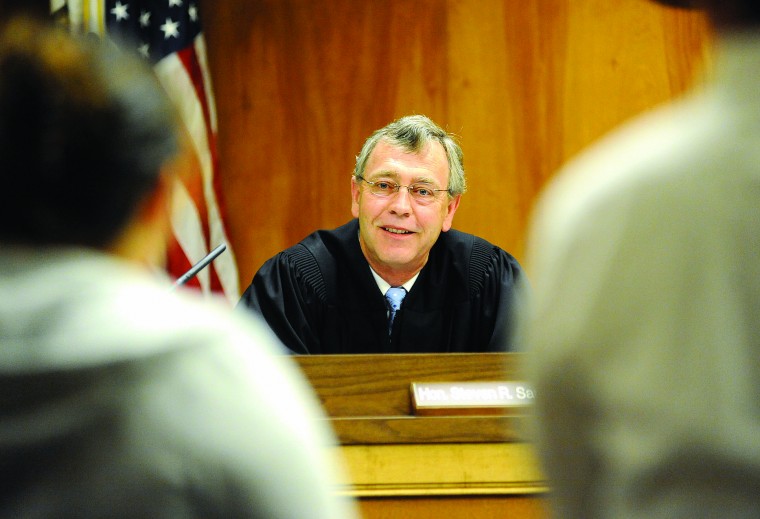
Socorro Del Real teared up Wednesday morning as she stood in Courtroom 1 of the San Benito County Superior Courthouse for her last session of drug court.
“It feels like I finally accomplished a goal,” Del Real said. “I worked a lot on my issues. I worked on a lot that made me reach out to drugs and alcohol.”
Del Real graduated from the program this week, receiving accolades from Judge Steven Sanders who presides over the cases, David Garcia, a substance abuse counselor, and her probation officer. For the year she has been in the program, Del Real has shown up to her scheduled court hearings, met with her probation officer, attended Alcoholics Anonymous and Narcotics Anonymous meetings, and tested clean for drugs.
The graduation is a welcome success for the agencies involved in the program as they prepare to celebrate National Drug Court Month in May. For Del Real, it’s a personal success.
“I was facing six years in prison,” Del Real said. “I was very relieved to have this option. I’ve been in the penitentiary a few times.”
She didn’t want to go back so she gave drug court a shot. The program is one of three that are offered in San Benito County for non-violent drug offenses, though Sanders is clear that the charges facing the clients are serious. First time offenders have the option of a deferred entry of judgment program – where they attend drug classes and NA or AA meetings before having their charges cleared. Non-violent second-time offenders may qualify for substance abuse treatment instead of jail time through Prop. 36.
“Those who’ve maybe gone through both those programs unsuccessfully may qualify for drug court,” Sanders said.
For the first few weeks in the drug court program, people have to appear in court once a week, show up for substance abuse meetings several times a week, check in with probation and get tested for drugs regularly.
The program offers rewards for those who are doing well, including the accumulation of points to move onto the next phase of the program where the court appearances drop to every other week and other requirements are less intensive. Each time they appear in court and have done well for the week, they get to draw from a reward jar. The jar has affirmations, small and large prizes, such as gift cards. The last phase of the program has clients coming in once a month to check in.
Renee Hankla, the substance abuse program manager for the county’s Behavioral Health department, said the clients get six to eight months to complete each phase. They can have points demoted if they don’t follow the requirements set for them. Other sanctions can include writing a letter, spending the day in court with Sanders up to spending a night or weekend in jail.
“If it’s been eight months (in one phase) we will evaluate if they are still right for the program,” Hankla said.
Before each Wednesday morning session of drug court, Sanders, Hankla and Garcia meet with representatives from the probation department and the district attorney’s office, along with the client’s public defender to discuss each case.
In closed session, they discuss the progress the person is making, what challenges they are facing and if someone is slipping. On a recent Wednesday morning they discussed a course of action that might help someone who has missed some substance abuse meetings and probation check ins.
“The main thing that stands out is it mandates clients’ structure,” Garcia said. “It gives them a daily, weekly schedule of things that are involved in recovery.”
He said often people do well in a residential treatment setting, but when they return to the everyday stressors they relapse.
“They have to do a lot of work on themselves and really apply it,” he said.
Greg La Forge, a public defender who represents the clients, said the staff meetings seem to make the clients more accountable.
“They seem to be more honest and forthcoming,” he said, noting that perhaps they realize that the group will all be discussing their progress.
For Del Real, the intensive requirements at the beginning of the program helped her to stay focused. She noted that she attended 90 meetings in 90 days. But more than that she said she embraced the requirements this time and incorporated a lot of activities with her church. In the past when she went through programs she said she would “skip and dodge” AA and NA meetings. She would get sober for a short time, but she would always relapse when things got tough.
This time, she said she used the services at Behavioral Health to deal with the issues that led her to substance abuse in the first place.
“I think I had been wanting this for a long time,” she said.
Del Real did volunteer work during the year she has been working through her drug court requirements and has become a sponsor for others attending substance abuse meetings. She also reconnected with her family who she said she avoided when she was using. She has built relationships with the people she met at AA and NA.
“I feel I have the resources,” she said. “I have a lot of friends who are sober now.”
Del Real teared up again as she talked about her experience.
“I was the person who was least likely to succeed,” she said. “It shows people out there struggling that they can do it, too.”









